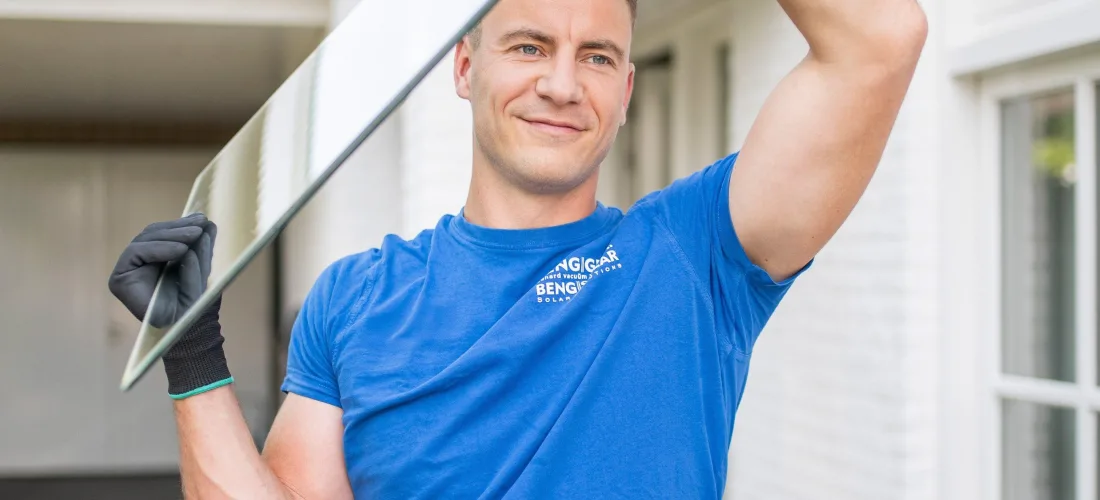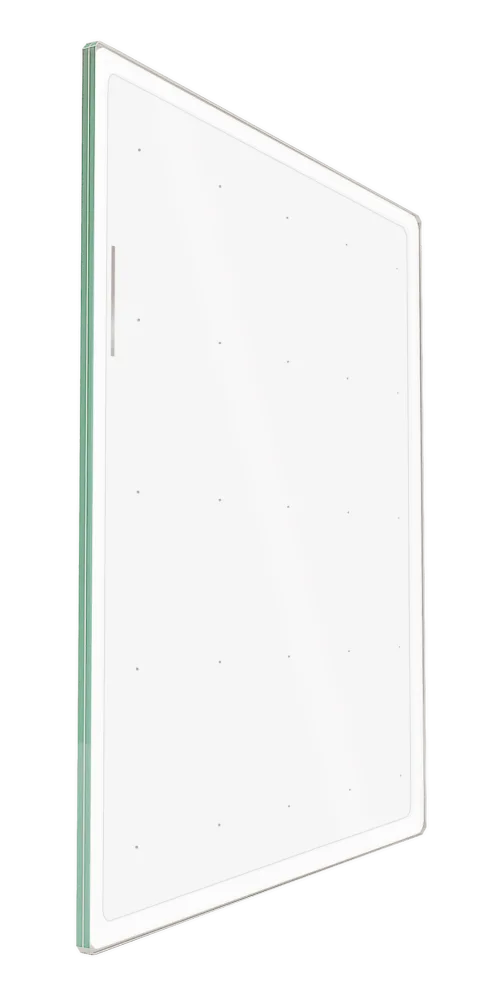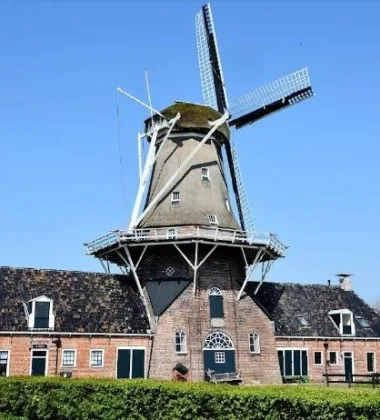Aannemervak.nl | 21 April 2021
Glass remains the weak link in the thermal insulation of a house or building. Even HR++ glass does not exceed the performance of a facade with an Rc of less than 1.0. Triple glazing is better, but often does not fit in the existing frames. So what are the possibilities to improve the insulation value while maintaining the existing frames?
One of the solutions for this is the application of vacuum glass. Vacuum glass consists of double glazing with a small cavity that is vacuum-sealed. To withstand the pressure from the vacuum, small spacers – microspacers – are placed between the panes. A valve may also be visible at the spot where the glass has been vacuum-sealed. With the double pane and the small cavity, the glass is limited in weight and often fits in existing rebates. The performance is comparable to or even better than triple glazing.
On the Dutch market, there are mainly two producers of vacuum glass active: AGC with Fineo and LandVac®, which is marketed through Global Glass Group. Giga-Glas also supplies LandVac glass but does so under the name BENG glass.

Lowest U-value
LandVac is the glass with the lowest U-value and therefore the highest insulation value. The U-value is 0.45, which is even better than triple glazing (U-value 0.5 – 0.9). According to Arnaud Roozen, sales director of Global Glass Group, this has become possible through new glass techniques and machines, including ultra-flat glass.
Due to this process, LandVac's vacuum glass is made up of two layers of tempered glass. The weight is 20 kg/m2, which is less than the weight of HR++. The pane thickness is 8.3 mm. The two tempered panes are favorable for sound insulation (RW>38dB). LandVac is available up to a maximum of 1500×2500 mm; production sizes up to 2000×3000 mm are in development.
Still a lot of unfamiliarity
Global Glass Group has already supplied and installed vacuum glass in a number of projects. “Mainly projects of 20 to 50 square meters. The large projects are yet to come. There is a lot of interest in the orientation phase, but decision-making for larger projects by corporations and homeowners' associations always takes a long time. In addition, we have only been on the market for a year and have not been able to attend trade fairs. We notice that there is a lot of unfamiliarity, especially about the details of vacuum glass. The market does not yet know what is and isn't possible with it.”
There are also many questions about the appearance of the glass. “Those who receive a sample immediately notice the microspacers. People who come to the model home never comment on it. Certainly, from a distance of one and a half meters, they are not visible. And the vacuum plug often disappears behind curtains or a plant or such.”
BENGglas
The glass from LandVac is also marketed by Giga-Glas from Goirle. Giga-Glas does this under the name BENGglas. The company supplies another variant with the same performance under the name BENGglas Pro. With this second type, Giga-Glas aims to offer a wide range of products. BENGglas Pro has a slightly wider edge, but no vacuum cap.
Director-owner John Creutzberg: “We market it as glass with a low U-value; the lowest in the world. But in practice, the high sound insulation due to the tempered panes also proves to be an important argument.”
The projects realized so far are still small. According to Creutzberg, the big ones are coming. Giga-Glas notices a great interest in vacuum glass from a broad market. “Only the window frame suppliers are lagging behind. They take little initiative and simply follow the specifications.” However, Creutzberg is convinced that vacuum glass has a future. “All major glass suppliers are working on building factories for it. They will soon enter the market with enormous marketing power.”

Freedom of Form
Fineo by AGC is vacuum glass with a U-value of 0.7. It is made with panes of standard glass. Fineo is produced in Belgium, resulting in short delivery times. The possibilities are also vast. “We can also make models, in any shape. For example, arched or round.” Fineo is also available in the Heritage variant, suitable for monuments. “We laminate Fineo with a pane of drawn glass.” Fineo Heritage comes in three variants: young classic; artisanal and traditional.
With Fineo, the aesthetic aspect is particularly noticeable, or rather not: the vacuum caps are absent. “We vacuum the pane from the edge, which we then seal ceramicly,” says product manager Vincent Hulleman of AGC Glass.
Different Thicknesses
With a U-value of 0.7, Fineo is thermally comparable to triple glazing and significantly better than HR++ (U-value 1.1). The glass is available in different thicknesses from 6.7 to 11.7 mm. This mainly depends on the size of the pane, due to wind pressure and load. The weight of Fineo at a thickness of 8 mm is 20 kg/m2. The thickness of the pane also has limited influence on the properties of sound insulation and light entry. The dimensions of Fineo are a maximum of 1500×2500 or 1600×2400 mm.
Fineo has been on the market for about a year, but AGC has already carried out several projects with it. These range from 20 to 100 and even 1,000 panes. Recently, AGC received an order for no less than 5,000 panes for the Van Gendt halls on Oostenburg in Amsterdam. The plan is to renovate this national monument to be energy neutral.
Fineo is used in monuments, as well as in renovation projects. In particular, the moving parts of existing frames are often not suitable for thick glass, while vacuum glass fits in without any problems, Hulleman says.
Adapting Existing Frames
Besides installing vacuum glass, it is also possible to adapt existing frames so that they are suitable for triple glazing. This can be done relatively easily with a circular concept developed by ADS Group Supply Construction from Goor to upgrade the existing frame instead of replacing it. Operations manager Arend Jan Overbeek devised the concept of the ‘stop strip’. This is a profiled strip placed in the existing rebate. Triple glass is then placed against it from the inside. A new glazing bead is added on the inside. This minimally reduces the glass surface.
Overbeek applied the concept once in a house and also attracted considerable interest. Nevertheless, the concept has not progressed beyond this one trial house so far. “It works fine and is quite cost-effective compared to completely replacing frames with plastic, but it’s a matter of ‘rethinking’. Painting companies are not carpenters, and this falls outside their normal calculations. It involves adapting the frame, installing new glass, and painting the interior and exterior. And all within the guarantees a company must provide. I see that many individuals still choose to replace with plastic frames.”
Not a Universal Product
Overbeek would have preferred the concept to be suitable for making a universal product that would come pre-primed on the shelf and that every painter would have a few in their van. “Unfortunately, the market is not ready for it yet. It requires different thinking from buyers. There needs to be broader attention for new concepts like the ‘stop strip’ to start producing and applying them extensively. Additionally, upgrading to a universal product in the market is a challenge; it takes time and energy.”
ADS Group Supply Construction has the knowledge and expertise to bring this product to market, and the product has already been successfully tested. They would also like to get in touch with potential clients to give such products a good chance together. “It’s a universal idea that anyone can apply.”
Making Triple Glass with Film
Another development to achieve higher insulation values in existing frames involves applying a film ‘stretched’ in the air cavity, converting existing double glazing into triple glazing, for example, with leaky or poor panes. The weight remains the same; the insulation value increases significantly. Old double glazing reaches approximately HR++ level (U-value 1.0), and glass that already has a (hard, pyrolytic) coating can even go to 0.7.
This technique is still experimental, however, and was first carried out during a workshop by Booosting, led by Bart van der Werf – Logtenberg of BW-Bouwadvies and Wout Hoogendoorn of Si-X. During the workshop, double panes were completely disassembled and rebuilt with a PET film (with vapor-deposited coating) in the middle of the air chamber.
Rethinking
According to Wout Hoogendoorn, it involves existing techniques and products, although the execution in this manner is new. He indicates that it is not a problem to do this with glass that has a hard coating (e.g., K-glass). With soft coatings, it becomes more difficult because they are more sensitive to oxidation. Soft coatings must therefore be completely removed in principle. However, Wout Hoogendoorn also sees possibilities for further improving the applied film with coating to achieve higher insulation values.
Disadvantage of this technique: glass suppliers are obviously not eager for it, and consumers and clients are not yet eager to pay the bill. “You keep your old glass and don’t get something new. And it’s not cheaper than new glass.” However, it does prevent a huge amount of waste. “But it will take another generation before we start rethinking and weigh its importance more heavily than the financial interest.”
Source: aannemervak.nl
Date: April 21, 2021
View the article


